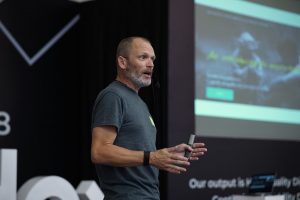Everyday practices in agile, Scrum, XP, Kanban, and continuous delivery
Since the introduction of the waterfall model in 1970 as an approach for software development projects, a lot has evolved. In the 1990’s similar ideas around iterative and agile software development where introduced simultaneously in more and more organizations and projects, resulting in the agile manifesto. During this one day workshop, speaker Sander Hoogendoorn, independent consultant, CTO at Klaverblad Insurances and author of the highly appreciated book This Is Agile, will demonstrate how agile projects operate, independent of any specific approach.
Although you can read a lot about Sander's over 20 years of experience with agile development in his brand new book This is Agile, it is always a joy and an inspiration to listen to Sander Hoogendoorn himself. We highly recommend this seminar to anyone who is involved in the software development process.
Patrick van Renterghem - CEO, IT Works, Belgium.
Next, from his twenty years of experience in agile and iterative projects, Sander compares the principles, best practices, roles and techniques from well-known approaches such as Scrum, Extreme Programming, Smart and DSDM. He will explain techniques such as stand-up meetings, retrospectives, pair programming, and test-driven development. Sander will also address how agile projects can evolve into even more effective flow-based approaches, such as Kanban, and continuous delivery. Sander touches on many of the strengths and weaknesses of each of these approaches and will illustrate this with many, many examples from his projects.
Moreover, he will use eye-opening hands-on exercises so participants will be able to experience the difference in effectiveness themselves real-time.

Benefits of attending
- Get a clear understand of the strengths and weaknesses of the different approaches for software development
- Learn to understand how agile works, independent of any particular agile framework
- Help you understand how Scrum and Extreme Programming work in practice
- Learn how your project will benefit from applying agile best practices and techniques, such as stand-up meetings, retrospectives, pair programming, and multi-disciplinary teams
- See real-life examples of using several types of agile dashboards
- Learn how you might evolve from agile approaches to flow-based approaches such as Kanban
- Learn about continuous integration and continuous delivery, and how that affects your projects
Who should attend
- Managers who have definite issues with their current approaches for software development projects, such as poor maintainability, long time-to-market, and are considering moving towards agile, Scrum or Kanban
- Managers who want to understand the challenges and opportunities agile approaches will offer
- Project managers who would like to find out how their role changes completely in agile and flow-based approaches
- IT professionals who want to understand how agile will influence the ways they collaborate in teams and are investigating DevOps
- Business analysts, functional analysts, developers and for sure testers who want to understand if and how their design techniques fit in agile, and how their roles change
- IT Managers and IT Strategists selecting new ways of working for their organizations and projects
- IT Architects and Managers who need to develop an integration strategy for their company
- Consultants who need to recommend different strategies for implementing agile approaches
Good and bad examples
Of course, all topics come with good and bad examples from my fifteen years of experience in coaching and running agile projects. I have presented this workshop over fifty times already, both in-house and through various independent organizers. All participants receive a copy of my book This Is Agile.
Organize in-house?
If you want to organize this interactive workshop in-house, tailored to your needs, please contact me at the email adress below:
Agenda
Why waterfall won’t work
- Introducing the waterfall model
- Why waterfall won’t work
- Explaining Boehm’s Law
- What waterfall should have been
- Next steps in software development approaches
- The Unified Process and the Spiral Model
What does being agile really mean?
- The Agile Manifesto
- What makes a project agile?
- Introducing the product backlog
- Working in iterations
- Planning your iterations
- Retrospectives
- Dealing with new and changing requirements
- Boehm’s Law applied to agile
An introduction to Scrum
- Explaining Scrum ceremonies
- Scrum roles
- The development team
- What does the product owner do?
- What does a Scrum master do?
Extreme programming and agile practices
- Extreme programming in a nutshell
- Agile best practices
- Collaborating with the customer
- Stand-up meetings
- Distributed stand-up meetings
- Burn-down and burn-up charts
- Pair programming and side-by-side programming
- The Definition of Done
Using agile dashboards
- The Scrum task board
- Stand-ups and dashboards
- Visualizing you flow
- Digital agile dashboards
- Speedbird9, Mingle, Jira Agile
Agile beyond agile: Kanban
- The red sprint anti-pattern
- Boehm’s Law applied to flow
- Introducing Kanban
- Kanban boards
- Optimizing your flow
- Using the Theory of Constraints
- Limiting your work-in-progress?
Moving to continuous delivery
- Small increments or big releases?
- Roadmap over planning
- Minimal viable products
- Continuous delivery
- Continuous deployment
- Those who build it, run it: DevOps
Retrospective
- Some final thoughts